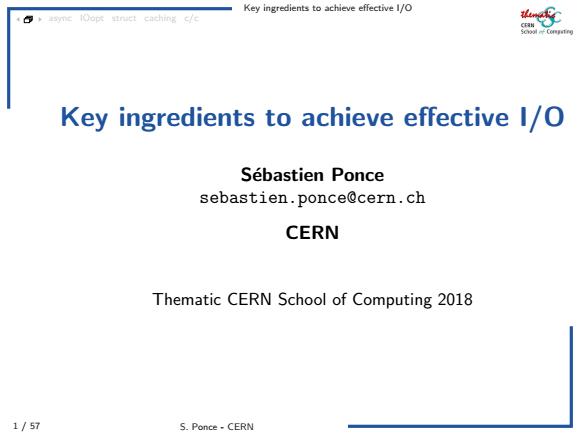
Key ingredients to achieve effective 1/O 4 asycop nct caching c/e Key ingredients to achieve effective l/O Sebastien Ponce sebastien.ponce@cern.ch CERN Thematic CERN School of Computing 2018 1/57 S.Ponce-CERN
Key ingredients to achieve effective I/O 1 / 57 S. Ponce - CERN async IOopt struct caching c/c Key ingredients to achieve effective I/O S´ebastien Ponce sebastien.ponce@cern.ch CERN Thematic CERN School of Computing 2018
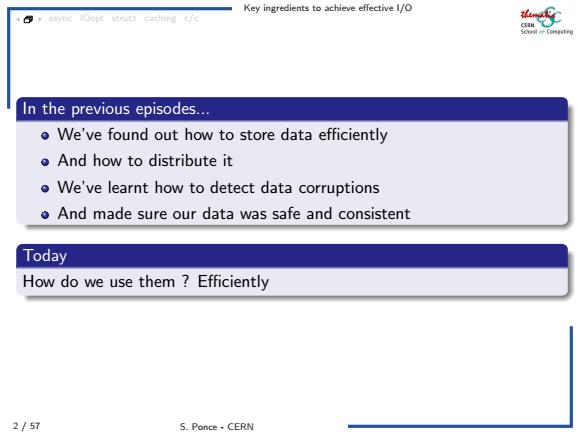
Key ingredients to achieve effective 1/O syme 0opt snict caching c/e “ In the previous episodes... o We've found out how to store data efficiently o And how to distribute it o We've learnt how to detect data corruptions o And made sure our data was safe and consistent Today How do we use them Efficiently 2/57 S.Ponce-CERN
Key ingredients to achieve effective I/O 2 / 57 S. Ponce - CERN async IOopt struct caching c/c In the previous episodes... We’ve found out how to store data efficiently And how to distribute it We’ve learnt how to detect data corruptions And made sure our data was safe and consistent Today How do we use them ? Efficiently
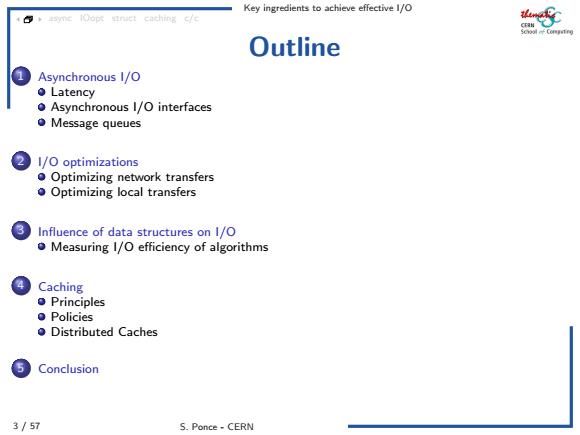
Key ingredients to achieve effective 1/O ye I(op nct caching c/e Outline ① Asynchronous 1/O Latency Asynchronous l/O interfaces ●Message queues 2 I/O optimizations Optimizing network transfers Optimizing local transfers Influence of data structures on I/O o Measuring I/O efficiency of algorithms Caching o Principles Policies ●Distributed Caches 3 Conclusion 3/57 S.Ponce-CERN
Key ingredients to achieve effective I/O 3 / 57 S. Ponce - CERN async IOopt struct caching c/c Outline 1 Asynchronous I/O Latency Asynchronous I/O interfaces Message queues 2 I/O optimizations Optimizing network transfers Optimizing local transfers 3 Influence of data structures on I/O Measuring I/O efficiency of algorithms 4 Caching Principles Policies Distributed Caches 5 Conclusion

Key ingredients to achieve effective 1/O 4心async0op时anet caching c/e Asynchronous 1/O ①Asynchronous I/O Latency Asynchronous l/O interfaces ·Message queues ②l/0 optimizations Influence of data structures on 1/O Caching Conclusion tancy ac mi名 4/57 S.Ponce-CERN
Key ingredients to achieve effective I/O 4 / 57 S. Ponce - CERN async IOopt struct caching c/c latency async msgQ Asynchronous I/O 1 Asynchronous I/O Latency Asynchronous I/O interfaces Message queues 2 I/O optimizations 3 Influence of data structures on I/O 4 Caching 5 Conclusion

Key ingredients to achieve effective 1/O asyncOop4nut caching c/c Sources of I/O latency Physical constraints preparing an SSD(~100 us) moving disk's arm (10ms) o mounting and rotating tapes(~1 min) Network infrastructure o number of switches routers on the way 200 us delay per switch/router "slow"speed of light "speed"of light is slower in a fiber(refractive index 1.47) ·that gives around200mμs-1or20cmns-1 o Budapest's ping time from CERN is ~21ms for ~2500km latency ac mig 5/57 S.Ponce-CERN
Key ingredients to achieve effective I/O 5 / 57 S. Ponce - CERN async IOopt struct caching c/c latency async msgQ Sources of I/O latency Physical constraints preparing an SSD (∼ 100 ➭s) moving disk’s arm (∼ 10 ms) mounting and rotating tapes (∼ 1 min) Network infrastructure number of switches routers on the way 200 ➭s delay per switch/router “slow” speed of light “speed” of light is slower in a fiber (refractive index 1.47) that gives around 200 m ➭s −1 or 20 cm ns−1 Budapest’s ping time from CERN is ∼21 ms for ∼2500 km
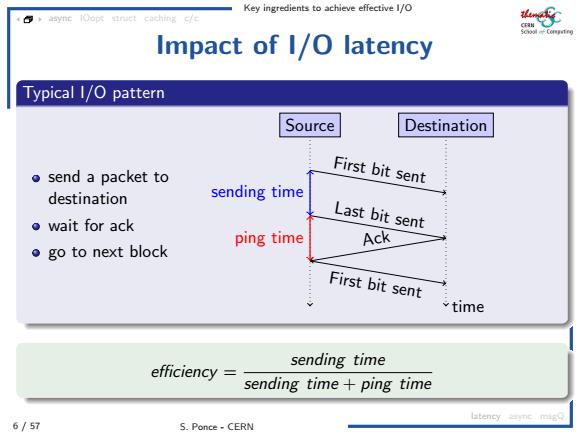
Key ingredients to achieve effective 1/O asyne caching c/e Impact of I/O latency Typical I/O pattern Source Destination ●send a packet to First bit sent destination sending time ●wait for ack Last bit sent ping time Ack ●go to next block First bit sent time sending time efficiency sending time+ping time latency ze mg 6/57 S.Ponce-CERN
Key ingredients to achieve effective I/O 6 / 57 S. Ponce - CERN async IOopt struct caching c/c latency async msgQ Impact of I/O latency Typical I/O pattern send a packet to destination wait for ack go to next block Source Destination time First bit sent Last bit sent Ack First bit sent sending time ping time efficiency = sending time sending time + ping time
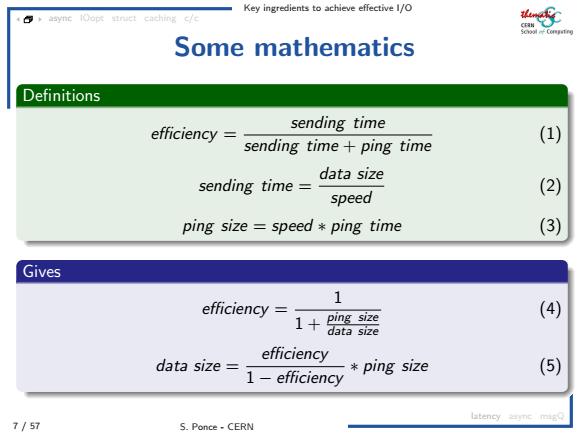
Key ingredients to achieve effective 1/O asyne Copt stnct caching c/e Some mathematics Definitions efficiency= sending time (1) sending time+ping time data size sending time = speed (2) ping size speed ping time (3) Gives 1 efficiency (4) 1+ ping size data size efficiency data size= 1-efficiency ping size (5) latency ac mig 7/57 S.Ponce-CERN
Key ingredients to achieve effective I/O 7 / 57 S. Ponce - CERN async IOopt struct caching c/c latency async msgQ Some mathematics Definitions efficiency = sending time sending time + ping time (1) sending time = data size speed (2) ping size = speed ∗ ping time (3) Gives efficiency = 1 1 + ping size data size (4) data size = efficiency 1 − efficiency ∗ ping size (5)
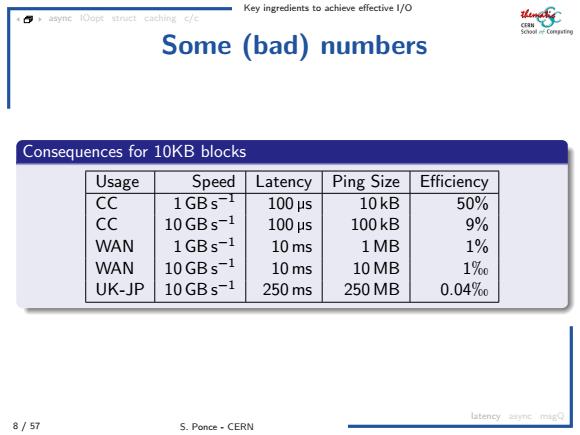
Key ingredients to achieve effective 1/O asyne Copt stnct caching c/e Some (bad)numbers Consequences for 10KB blocks Usage Speed Latency Ping Size Efficiency CC 1GBs-1 100μs 10kB 50% cc 10GBs-1 100μs 100kB 9% WAN 1GBs-1 10ms 1MB 1% WAN 10GBs-1 10ms 10MB 1%0 UK-JP 10GBs-1 250ms 250MB 0.04%0 latency ac mig 8/57 S.Ponce-CERN
Key ingredients to achieve effective I/O 8 / 57 S. Ponce - CERN async IOopt struct caching c/c latency async msgQ Some (bad) numbers Consequences for 10KB blocks Usage Speed Latency Ping Size Efficiency CC 1 GB s−1 100 ➭s 10 kB 50% CC 10 GB s−1 100 ➭s 100 kB 9% WAN 1 GB s−1 10 ms 1 MB 1% WAN 10 GB s−1 10 ms 10 MB 1h UK-JP 10 GB s−1 250 ms 250 MB 0.04h
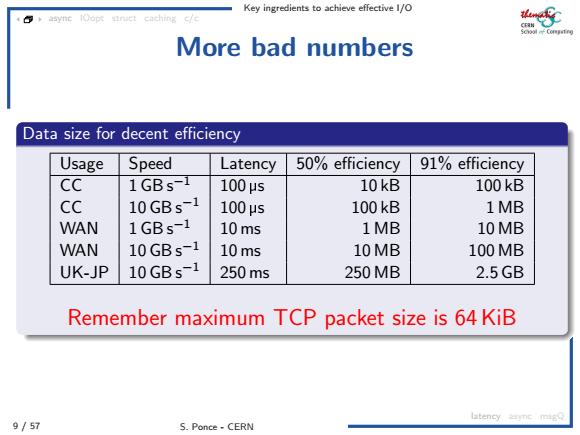
Key ingredients to achieve effective 1/O asyne IOopt snact caching c/c More bad numbers Data size for decent efficiency Usage Speed Latency 50%efficiency 91%efficiency CC 1GBs-1 100μs 10kB 100kB CC 10GBs-1 100μs 100kB 1MB WAN 1GBs-1 10ms 1MB 10 MB WAN 10GBs-1 10ms 10MB 100MB UK-JP 10GBs-1 250ms 250MB 2.5GB Remember maximum TCP packet size is 64 KiB latency ac mig 9/57 S.Ponce-CERN
Key ingredients to achieve effective I/O 9 / 57 S. Ponce - CERN async IOopt struct caching c/c latency async msgQ More bad numbers Data size for decent efficiency Usage Speed Latency 50% efficiency 91% efficiency CC 1 GB s−1 100 ➭s 10 kB 100 kB CC 10 GB s−1 100 ➭s 100 kB 1 MB WAN 1 GB s−1 10 ms 1 MB 10 MB WAN 10 GB s−1 10 ms 10 MB 100 MB UK-JP 10 GB s−1 250 ms 250 MB 2.5 GB Remember maximum TCP packet size is 64 KiB

Key ingredients to achieve effective 1/O 4aync0o时natt cachinc The solution asynchronous I/O Do not wait the acknowledgment Source Destination ocall an API to express what First bit 1 should be transfered o this immediately returns 电 without doing much ●get called back when transfer has been done/has failed 超093 Ack 3 time latency asyne mig 10/57 S.Ponce-CERN
Key ingredients to achieve effective I/O 10 / 57 S. Ponce - CERN async IOopt struct caching c/c latency async msgQ The solution : asynchronous I/O Do not wait the acknowledgment ! call an API to express what should be transfered this immediately returns without doing much get called back when transfer has been done/has failed Source Destination time First bit 1 Last bit 1 Ack 1 First bit 2 Last bit 2 Ack 2 First bit 3 Last bit 3 Ack 3 First bit 2 Last bit 2 Ack 2 First bit 3 Last bit 3 Ack 3 First bit 4 Last bit 4 Ack 4 First bit 5 Last bit 5 Ack 5